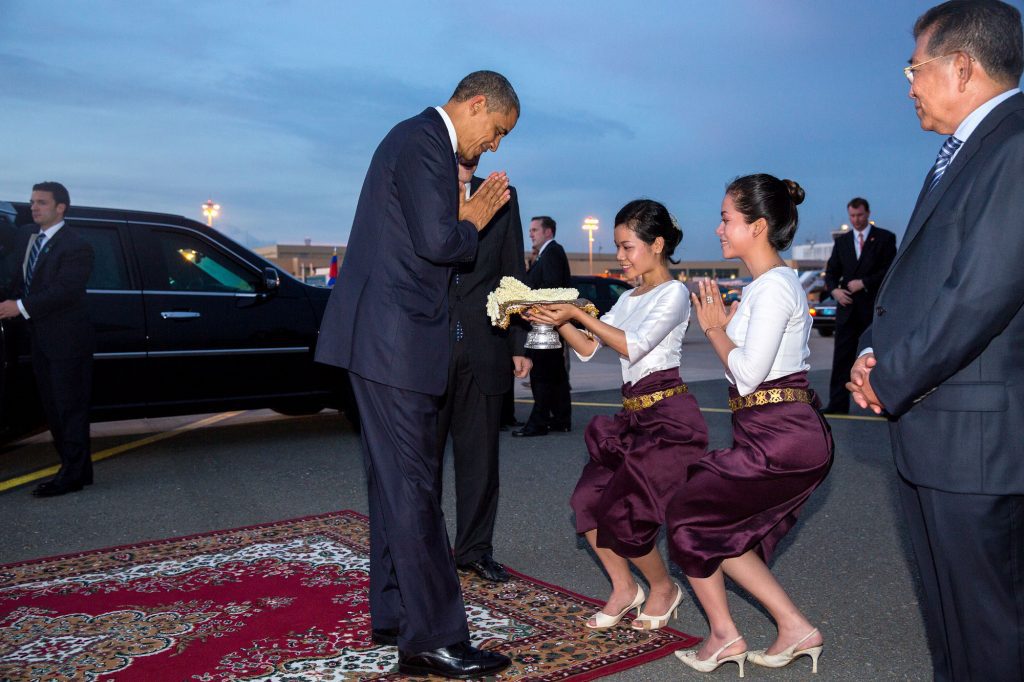On November 14, 1950, the US Legation opens in Phnom Penh- preceding the opening of an embassy. Operations were initially conducted from the Hotel Le Royal until a Legation office and U.S. Information Service library were established in a new location. Donald R. Heath had presented his credentials in July.

On November 14, 1991, Prince Sihanouk finally returns to Phnom Penh after spending years in exile. His homecoming was possible thanks to the Paris Peace Accords signed the previous month.


On November 15, 1967, the West German Embassy in Phnom Penh opens, and the Kingdom of Cambodia and the Federal Republic of Germany officially establish formal diplomatic relations.
On 15 November 1972, The Cambodian Army, Forces Armees Nationale Khmer (FANK) recapture Trapeang Kraleng in Military Region II, 35 miles west of Phnom Penh, that had been under the Communist control since 1 Nov. 1972.
On November 15, 1975, Prince Nordom Sihanouk of Cambodia left Peking to begin a tour of countries friendly to the Communist Government in Cambodia. Prince Norodom Sihanouk first met with Pakistan’s Prime Minister. Zulfikar All Bhutto, during two‐hour stopover on his way to Baghdad.
A Chinese airliner will he used for the tour, which is to include Iraq, Syria, the Sudan, Yemen, Somalia, Tanzania, Uganda, Yugoslavia, Rumania, Albania and Pakistan.
Three weeks ago a Cambodian communique announced that the Prince would visit “about 20 friendly countries.” The list was reduced because there were “difficulties in making the arrangements,” an official source said.
On November 16 2015, the US Navy held the 6th Cooperation Afloat Readiness and Training (CARAT) Cambodia exercise at the Royal Cambodian Ream Navy Base.
On 16 November 2017, the Supreme Court of Cambodia ruled to dissolve the opposition CNRP. “There is no future for CNRP since November 16, 2017,” CPP spokesman Sok Eysan told Al Jazeera.
On November 16, 2018, Khmer Rouge leaders Nuon Chea and Khieu Samphan were convicted of genocide, crimes against humanity and grave breaches of the Geneva Conventions of 1949. The pair were already serving life sentences for crimes against humanity after the first trial in 2014.
On November 17, 1947, Battambang, Siem Reap, and Sisophon returned to Cambodia after being annexed by Thailand in World War II.
On November 17, 1975, An official Thai-Cambodian Liaison Committee is established at Aranyaprathet and Poipet on the Thai / Cambodian border.
On November 17, 1985, former Khmer Republic leader Lon Nol died in Fullerton California.

On November 17, 2011, Judges halt proceedings against Ieng Thirith, Minister of Social Affairs from 1975-79, and wife of Ieng Sary/sister-in-law of Pol Pot, saying she is unfit for trial because she has been diagnosed with dementia. The court later rules she will remain detained for at least six more months while undergoing medical treatment.

On November 18, 1984, on the Thai border, Nong Chan Refugee Camp was attacked by over 2,000 soldiers of the PAVN 9th Division and fell after a week of fighting, during which 3 Vietnamese captains and 66 Cambodian soldiers of the KPRAF were killed. 30,000 civilians were moved to evacuation Site 3 (Ang Sila) then to Site 6 (Prey Chan). It was part of the Vietnamese led 1984-85 Dry Season Offensive.
On November 19, 2012, U.S. President Barack Obama became the first ever sitting US leader to visit Cambodia. He arrived in Phnom Penh to attend the East Asia Summit.

On November 20, 1946, The Khmer Royal Army (Forces Armees Royals Khmeres – FARK) began, following the signing of a Franco-Khmer Military Convention. Under this, the first battalion of the FARK was created out of elements of the Cambodian Rifle Regiment of the French Army and the Khmer National Guard, a militia.
On November 20, 1962, a telegram was sent from the Embassy in Cambodia to the Department of State, showing the complicated situation already evolving in Cambodia, and the fraught relationship with Sihanouk. READ IT HERE
On November 20, 1991, the following political accord was signed between the former Communist incumbent government and their former Royalist enemies, paving the way for elections:
Accord between the Cambodian People’s Party (CPP) and the National United Front for an Independent, Neutral, Peaceful and Cooperative Cambodia (FUNCINPEC)
In view of effectively implementing the Agreement on a political settlement and promoting mutual trust;
In view of maintaining political stability in Cambodia and creating conditions favouring the accomplishment of His Royal Highness Samdech Norodom Sihanouk’s noble mission in the service of the nation;
The Cambodian People’s Party represented by H.E. Mr Hun Sen, and the National United Front for an Independent, Neutral, Peaceful and Cooperative Cambodia, represented by H.R.H. Prince Norodom Ranariddh, have agreed as follows:
Article 1: The two parties agree to cooperate fully in creating conditions favouring the accomplishment of H.R.H. Samdech Norodom Sihanouk’s mission in service of the nation. The two parties pledge to support H.R.H. Samdech Norodom Sihanouk’s candidature in the forthcoming presidential elections in Cambodia.
Article 2: The two parties agree to refrain from attacking each other from this day on and during the electoral campaign. The two parties pledge to make the necessary efforts to honour this commitment.
Article 3: The two parties agree to cooperate in the future National Assembly, and to do so regardless of the number of seats obtained by each party in the National Assembly, and to form a coalition government based on the supreme interests of the nation.
Article 4: The two parties agree to build on this cooperation to lay a solid basis for realising national reconciliation and contributing to social stability.
Article 5: This accord, which is the fruit of sincere goodwill, represents the basis for cooperation between the two political forces at the present time and in the future.
Article 6: Upon signature of this accord, the two parties will name their respective representatives to consult and resolve together any problems which might arise during its implementation.
Signed in Phnom Penh, 20 November 1991
In the name of FUNCINPEC, Norodom Ranariddh
In the name of the CPP, Hun Sen
